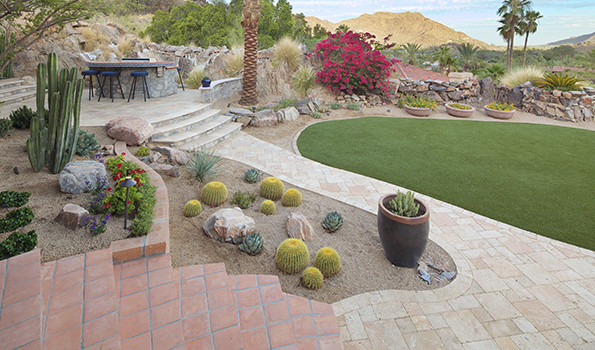There Are No Perfect Plants in the Desert- Or Anywhere!
Custom Landscape, Unique Landscapes, Annuals
Planning a new landscape palette for your home can be very time consuming if you are looking for perfect plants. As a rule, there are no very colorful, low debris, low water plants that thrive in the heat of the Phoenix and the cooler winter weather, that don’t have thorns and need very little maintenance. There is always going to need to be a bit of compromise. But there are actually some great options which come close to meeting all of these qualifications and will look great in your yard.
Desert Landscape Can Be Beautiful
Most homeowners, even those in Phoenix, cringe when they hear the term desert landscape. It congers up an image of dust, dirt, rock and a lot of thorns. In short, it is not what anyone wants to use to create their UNIQUE outdoor living space. But having an open mind and investing just a little bit of time can open your eyes to a great plant palette that offers beauty, color and texture variations without a lot of mess to clean up or the need to be pruning, trimming and thinning on a regular basis. And as an added bonus, all of these plants require little or no supplemental watering and will look great throughout the year.
Plan You Plant Selections
Agaves are a great place to start as there are many varieties, colors, shapes and sizes. Larger selections such as the Century Plant, the Octopus Agave and the Variegated Agave will all grow to the size of a medium shrub and provide different shades of green and even yellow. In addition, their growth habit is quite UNIQUE and will add e great deal of visual interest without ever needing to be trimmed or shaped. The Parry’s Agave is a smaller plant and grows in a very formal rosette shape. It remains compact and spherical while adding a striking blue green to your color palette. The Twin-Flower Agave offers a deep green and a completely different texture as its leaves being much finer, almost like large pine needles.
Adding a few cactus can now bring in some larger plants. The Ocotillo has very long slender canes which can easily grow to 12’ or more and display clusters of orange to red flowers at the top of each cane. The shape is very vase like and though it is not a dense plant, it provide a sense of volume for large areas. The Indian Fig is a member of the prickly pear family and its large smooth pads provide the perfect contrast to the Ocotillo. Again, the Indian Fig is a larger plant that will grow to the size of a small to medium tree and will have a larger canopy and narrower trunk or base. Most varieties have no thorns which makes this a good selection to place near walkways, gates or a seating area.
The addition of a few smaller varieties of cactus will bring in the final size and dimension to complete your plant palette. Including a Beavertail Prickly Pear will add beautiful magenta flowers in the spring and a Purple Prickly Pear will add a hint of violet in the color of the pads year round. And no desert landscape is complete without at least one Gold Barrel. This cactus adds not only a nice spherical shape but a beautiful contrast of the green body and the golden thorns. The Fishhook Barrel offers a contrast of the deep green body and a larger thorn with a red to purple tone. Both of these barrels will also provide beautiful flowers in yellow to orange.
Additional Features and Interest
Adding mounds, river rock and a few boulders would complete this true desert landscape without the need for any regular watering, maintenance or trimming. But if this is just a little too authentic for your taste, you can easily blend in a few small plants and shrubs which will adhere to the desert theme but add a little more softness and color. Sage shrubs are available in many varieties and will provide a varied leaf color from a deep green to a light grey green and flowers from a pale almost blue color to a deep violet. The shrubs have very small leaves so there is little noticeable debris and the small leaves also tolerate the heat better than a larger leafed plant. Lantana also offers a range of colors including white, red, yellow, gold, purple and pink. These do create a little bit of debris but offer a great deal of color and little need for trimming in exchange.
When you are thinking about converting to a water friendly, xeriscape, landscape design there are a few key points to remember.
- Create elevation changes to add interest and create a focal point
- Blending textures and shapes can create as much interest as blending colors
- Select a few plants that attract wildlife such as birds and butterflies
- A dry creek bed of rip rap or river rock adds the illusion of motion to the space and will move your eye through the landscape; it can also be a useful path for water to flow out of the space during monsoon season
- Splashed of color and flowers can be added in pots which will require less care and water
Desert landscape is not all brown and sharp pointed objects. A wide array of shades of green can be found in cactus, agave and small shrubs. And each plant will not only bring with it a UNIQUE color but also a UNIQUE shape and growth habit. Blending all of these features together will allow you to create a beautiful and interesting landscape that requires little to no effort to maintain and used very little water. This will give you more time to enjoy relaxing in your outdoor living space instead of maintaining it.
